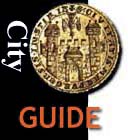
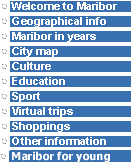
![]() Maribor
is the second largest city in Slovenia.
Additionally, it is also the economic and cultural centre
of northeastern Slovenia. It is situated at the
Maribor
is the second largest city in Slovenia.
Additionally, it is also the economic and cultural centre
of northeastern Slovenia. It is situated at the cross-section of traffic routes leading from Central to
southeastern Europe, and from western Central Europe to
the Pannonian Lowland. This
location (please also see where
is Maribor and how
to get to Maribor) has not only made Maribor
prominent in past and present history but, because of it,
Maribor's prominence is likely to continue in the future.
The climate is of a
middle-european to pannonian type. The commune of Maribor
today measures 356.6 km2. According to the 1981 census,
this area is inhabited by around 156,000 people.
cross-section of traffic routes leading from Central to
southeastern Europe, and from western Central Europe to
the Pannonian Lowland. This
location (please also see where
is Maribor and how
to get to Maribor) has not only made Maribor
prominent in past and present history but, because of it,
Maribor's prominence is likely to continue in the future.
The climate is of a
middle-european to pannonian type. The commune of Maribor
today measures 356.6 km2. According to the 1981 census,
this area is inhabited by around 156,000 people.
![]() In a millenium or so
Maribor has had its ups and downs. As its history shows, it was not a large
or important city until the middle of the eighteenth
century. Slowly it achieved prominence. It recieved fresh
impetus during the initial phase of
In a millenium or so
Maribor has had its ups and downs. As its history shows, it was not a large
or important city until the middle of the eighteenth
century. Slowly it achieved prominence. It recieved fresh
impetus during the initial phase of 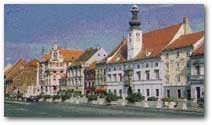 industrialization
in the second half of the nineteenth century. From a
peaceful, provincial town, inhabited by merchants,
craftsmen associated with several guild-organizations, a
sprinkling of clerks and soldiers, and a few members of
the nobility, Maribor has been transformed into an
economically and culturally dynamic city.
industrialization
in the second half of the nineteenth century. From a
peaceful, provincial town, inhabited by merchants,
craftsmen associated with several guild-organizations, a
sprinkling of clerks and soldiers, and a few members of
the nobility, Maribor has been transformed into an
economically and culturally dynamic city.
![]() All those
transformations during the time show up in the
picturesque city
All those
transformations during the time show up in the
picturesque city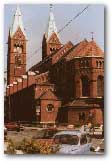 architecture, or you can find out
more about Maribors history, by visiting The Regional
Archives of Maribor. Today, Maribor's "trade
marks" are the University,
the National
Theatre with Opera, the Castle,
the Cathedral, the City Park with the
Aquarium, the Pohorje
hills, vineyards with the european
oldest vine (over 400 years old), the Plague Memorial, the Narodni dom (the National
Home), the Bus
Terminal, the Drava river
Banks, the City's Coat
of Arms.
architecture, or you can find out
more about Maribors history, by visiting The Regional
Archives of Maribor. Today, Maribor's "trade
marks" are the University,
the National
Theatre with Opera, the Castle,
the Cathedral, the City Park with the
Aquarium, the Pohorje
hills, vineyards with the european
oldest vine (over 400 years old), the Plague Memorial, the Narodni dom (the National
Home), the Bus
Terminal, the Drava river
Banks, the City's Coat
of Arms.
![]() Maribor is considered to
be a cheerful, friendly city. Some relate this pleasant
situation to its extensive wine-growing
regions that routinely invite visits from Maribor
residents. These vineyards are part of the natural beauty
of the city, along with the Pohorje
forests, the valley of the Drava river, the Kozjak
and the Kobansko ravines, or the Slovenske Gorice hills
and fields at the southeast of the city.
Maribor is considered to
be a cheerful, friendly city. Some relate this pleasant
situation to its extensive wine-growing
regions that routinely invite visits from Maribor
residents. These vineyards are part of the natural beauty
of the city, along with the Pohorje
forests, the valley of the Drava river, the Kozjak
and the Kobansko ravines, or the Slovenske Gorice hills
and fields at the southeast of the city. 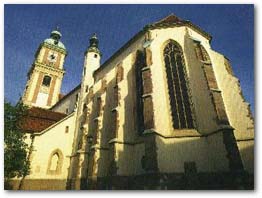 Mariborians are open, easy-going
people. Visitors may sometimes chide them for being
perhaps too fond of their city, for being too ready to
enter into competition with the more elegant centre of Ljubljana. But, such
sentiments, after all, cannot be but a healthy showing of
the pride and delight they take in observing day by day
the multidirectional growth of the city they live in.
Very quickly, the visitors will become familiar with local food and drink (especially
wines). After the gastronomy needs are taking care of,
let's do something for soul - perhaps you're interested
of fine arts, theatre or music.
Mariborians are open, easy-going
people. Visitors may sometimes chide them for being
perhaps too fond of their city, for being too ready to
enter into competition with the more elegant centre of Ljubljana. But, such
sentiments, after all, cannot be but a healthy showing of
the pride and delight they take in observing day by day
the multidirectional growth of the city they live in.
Very quickly, the visitors will become familiar with local food and drink (especially
wines). After the gastronomy needs are taking care of,
let's do something for soul - perhaps you're interested
of fine arts, theatre or music.
From Maribor it also possible to visit old town Ptuj, health resort centers Rogaska Slatina, Zrece, Atomske spa, Lasko spa, and Radenci, ski resorts Pohorje, Rogla, Kope, and Golte, natural jewel Logarska Dolina, and towns Slovenska Bistrica, Slovenjske Konjice, Lenart, Ruse, Slovenj Gradec, Celje, and Murska Sobota. More information about tourist atractions in Slovenia is in Slovenia official page, Slovenian tourist Board page.